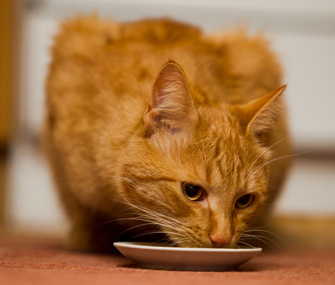How to Spot and Treat Feline Hyperthyroidism
Published on December 08, 2015
Skip To

What Is Hyperthyroidism?
Hyperthyroidism in cats is a disorder caused by excess production of thyroid hormone from either a benign growth or a tumor of the thyroid gland. Although almost all thyroid tumors in cats are benign and rarely spread, the disease they cause can be life threatening.That’s because thyroid hormones are intricately involved in the body’s metabolism. The high levels of thyroid hormones present in feline hyperthyroidism result in an “overactive” metabolism and exert negative effects on many body systems. Over time, these negative effects result in the most common signs of feline hyperthyroidism.
Top 5 Signs of Feline Hyperthyroidism
1. Weight loss. Weight loss is the most common sign in hyperthyroid cats and is seen in up to 98 percent of affected cats, even though they usually are eating adequate amounts of food. It is common for hyperthyroid cats to be underweight and exhibit an unkempt appearance.2. Increased appetite. At least 80 percent of owners of hyperthyroid cats report a hearty or very robust appetite. Affected cats often demand food and eat voraciously when presented with their meals; however, they continue to lose weight. This alludes to the seriousness of the overactive metabolism present in affected cats.
3. Increased urination and water drinking. High levels of thyroid hormones cause the kidneys to produce more urine. Owners of hyperthyroid cats will often notice more and larger clumps of urine in the litterbox. Some cats might also urinate outside the litterbox. Affected cats also drink more to compensate for the extra urine production but sometimes still develop dehydration.
4. Vomiting and/or diarrhea. Approximately 50 percent of hyperthyroid cats will experience some vomiting and/or diarrhea. Vomiting often results from rapid overeating. Hyperthyroid cats also experience rapid movement of food through their intestines, which may result in diarrhea and/or increased fecal volume.
5. Hyperactivity and/or behavioral changes. Owners of hyperthyroid cats often report increased activity and restlessness, as well as excess vocalization. Some affected cats may develop a tendency toward aggression and exhibit unpredictable or unusual behavior.
These are the most common signs of typical feline hyperthyroidism. However, due to routine screening of middle-age to older cats for this incredibly common hormonal disorder, many veterinarians are diagnosing hyperthyroidism earlier than ever before. As such, some affected cats may have only minor signs with limited abnormalities on their examinations. A small percentage of hyperthyroid cats may not exhibit any obvious disease signs at all.
Diagnostic Dilemmas
Several common diseases of older cats share some clinical signs with hyperthyroidism. These include diabetes mellitus, chronic kidney failure, inflammatory bowel disease or intestinal cancer. It is not uncommon to diagnose an older cat with more than one of these conditions simultaneously. Your veterinarian will need to perform an array of diagnostic tests to reach the diagnosis of feline hyperthyroidism.If your veterinarian suspects hyperthyroidism in your cat, the initial diagnostic tests generally include a complete blood count (CBC), blood chemistry panel, thyroid hormone analysis and a urinalysis. For most cats, these tests can confirm a diagnosis. However, up to 10 percent of hyperthyroid cats may have normal thyroid hormone levels in their blood, and the diagnosis in these cats may require some additional specialized testing.
What Do You Do If Your Cat Is Hyperthyroid?
Several treatment options are available. Each one has advantages and disadvantages, and your veterinarian will discuss the best plan for your cat. Here’s a brief overview of what they are:- Medication. Antithyroid medicine, called methimazole, is very commonly used and is highly effective at controlling hyperthyroidism. The medication can be administered orally or applied topically, which makes it more “user friendly” for some pet owners. Lifelong daily medication is required by most cats in order to adequately control their hyperthyroidism. Routine monitoring of bloodwork must also be performed in order for methimazole to be used safely and help minimize potential side effects.
- Surgery. Surgical removal of the thyroid glands results in a cure of affected cats (except in those rare cases where the cancer has spread). Not all hyperthyroid cats are candidates for surgery though, usually because of concerns about anesthesia. Your veterinarian will determine if surgery could be an option for your cat.
- Radioiodine treatment. Radioactive iodine therapy results in a cure of feline hyperthyroidism. An injection of radioactive iodine is administered and becomes concentrated in the abnormal thyroid gland(s), where it destroys the abnormal tissue. The procedure is not available at all veterinary hospitals — it must be done in a licensed facility and often necessitates a lengthy hospital stay. It can also be expensive for some owners.
- Diet. There is one prescription diet available, which can be used to control hyperthyroidism in some cats. The thyroid glands require iodine from food in order to make thyroid hormones. This prescription diet contains very low iodine levels, so the diseased thyroid glands do not have the necessary ingredient to overproduce thyroid hormones. Strict adherence to this diet is imperative.
More on Vetstreet:





